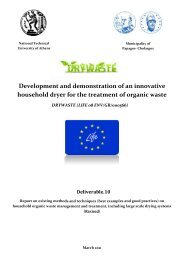MOROCOMP (LIFE TCY05/MA000141) - Unit of Environmental ...
MOROCOMP (LIFE TCY05/MA000141) - Unit of Environmental ...
MOROCOMP (LIFE TCY05/MA000141) - Unit of Environmental ...
You also want an ePaper? Increase the reach of your titles
YUMPU automatically turns print PDFs into web optimized ePapers that Google loves.
[ % ]<br />
6<br />
5,5<br />
5<br />
4,5<br />
4<br />
1 2 3 4 5 6 7 8 9 10 11 12 13 14 15 16 17 18 19 20<br />
[ Days ]<br />
Figure 40: Changes in total nitrogen content [%] during the 4 th composting trial<br />
The 4 th composting trial acquired the highest nitrogen content in comparison to the<br />
previous trials due to the origin <strong>of</strong> the composted raw material which comprised only<br />
<strong>of</strong> secondary sludge and perlite as an additive. The collected secondary sludge had<br />
increased nitrogen content as has been shown in Table 32 whereas the carbon content<br />
is low proportionally to the nitrogen content. According to Figure 40 the nitrogen<br />
content in the beginning <strong>of</strong> the process was 5.74% <strong>of</strong> which a significant amount was<br />
lost as ammonia and/or ammonium as the composting kept developing due to the<br />
excess <strong>of</strong> nitrogen in the substrate. Studies have shown that during the first phase <strong>of</strong><br />
the process the combination <strong>of</strong> high ammonium concentration, high temperatures, and<br />
raised pH lead to high ammonia losses. Also, high aeration <strong>of</strong> the composting piles<br />
increases the rate <strong>of</strong> volatilization <strong>of</strong> the ammonia formed [65]. As has been sated the<br />
level nitrogen losses by ammonia volatilization varies and can amount up to 50% <strong>of</strong><br />
the initial total nitrogen depending on the raw material that is used for composting<br />
[22, 23]. On the 13 th day nitrogen content acquired its minimum value <strong>of</strong> 4.55%, from<br />
that day onwards and as the substrate passed from the thermophilic stage to a second<br />
mesophilic phase the nitrogen content started to increase. This increase is probably<br />
attributed to the processes <strong>of</strong> nitrogen fixation by the activity <strong>of</strong> azotobacters which<br />
recover a proportion <strong>of</strong> nitrogen that has been lost as ammonia [2, 28]. The nitrogen<br />
content at the end <strong>of</strong> the 4 th composting trial on the 20 th day was 5.12%.<br />
113










